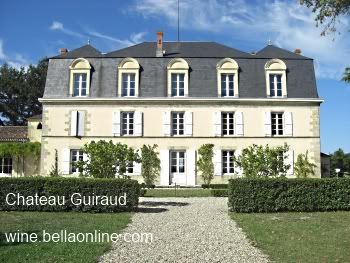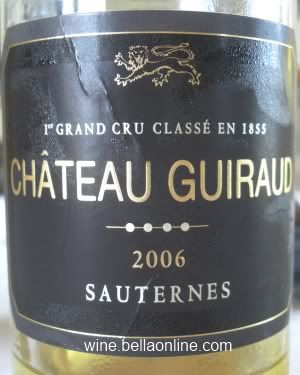Chateau Guiraud, Sauternes

The entrance drive to Chateau Guiraud in Sauternes, south of Bordeaux is a tree lined road that was originally built by the Romans.

Ch Guiraud has 128 hectares (ha) of which 100ha are planted with vines on clay and gravel soils, roughly 65% Semillon, 35% Sauvignon Blanc. They have 1.5 rows of Muscadelle and one vineyard of Sauvignon Gris. They also own an island in the river where they run a nursery propagating vines.

At the entrance to the chateau, erected built by Pierre Guiraud in 1766, is a strange collection of tiles and wood bored with small holes (pictured right). It is an ‘insect hotel’, the first indication that the vineyards are farmed organically – the chateau was the first classed growth to be certified and — and they are in transition to biodynamic certification.
If biodynamics is magic, so is how the sweet wine of Sauternes is produced. Sometime after flowering the baby grapes are touched by botrytis spores which lie dormant during summer till the right combination of mist and humidity activate them. They send microscopic tendrils through the ripe grape skin to feed on water in the grape. The grape shrivels into raisins as the grey bloom of this rot (called noble for its effect) feasts. Removal of water leaves just the sugary essence of the grape and by pressing grapes that look rotten the luscious sweet wine known as Sauternes can be made.
Not all grapes succumb, and some grapes are attacked by other detrimental rot and cannot be used. So grape pickers use scissors to pick individual berries and make many passes through the vines over a two month period.
After picking grapes are crushed and left to settle in large tanks to let sediment settle. Then the juice is pushed out with compressed air into new French oak barrels to ferment naturally.
Fermentation is stopped by cooling to -4C then the wine is returned the cleaned barrels. In January the winemaker tastes and makes his selections. In April is the en primeur tastings then the wine ages with a final assemblage in May—June. The wine is cold stabilised at -3C and fined with bentonite, then undergoes six months bottle aging.
Ch Guiraud has three bottlings.
The main wine, the classed growth Ch Guiraud has a black label in memory of Emperor Napoleon I. Petit Guiraud is the second label (previously it was named Le Dauphin de Guiraud) and there is a dry white wine called ‘G’.

Ch Guiraud 2006 has a pale colour, it is sweet (not not overly) with good acid balance, but it is tight and young and needs more time.
Ch Guiraud 2001 is a dark golden colour with rich sweet honeyed flavours.
Petit Guiraud 2009 was bottled just over a month before my visit and has a pea pod aroma and a delicate sweetness that I think will develop.
‘G’ 2010 is 80% Sauvignon Blanc, 20% Semillon is fresh an a crisply dry with less than 1gL residual sugar. It has been in wood and had lees aging. There is a fat richness in the middle palate and a persistent finish.
Ask questions and talk about wine on our forum.
Disclosure: Peter F May travelled to Bordeaux at his own expense and paid full price for all his accommodation, meals, tastings and wines.

Ch Guiraud has 128 hectares (ha) of which 100ha are planted with vines on clay and gravel soils, roughly 65% Semillon, 35% Sauvignon Blanc. They have 1.5 rows of Muscadelle and one vineyard of Sauvignon Gris. They also own an island in the river where they run a nursery propagating vines.

At the entrance to the chateau, erected built by Pierre Guiraud in 1766, is a strange collection of tiles and wood bored with small holes (pictured right). It is an ‘insect hotel’, the first indication that the vineyards are farmed organically – the chateau was the first classed growth to be certified and — and they are in transition to biodynamic certification.
If biodynamics is magic, so is how the sweet wine of Sauternes is produced. Sometime after flowering the baby grapes are touched by botrytis spores which lie dormant during summer till the right combination of mist and humidity activate them. They send microscopic tendrils through the ripe grape skin to feed on water in the grape. The grape shrivels into raisins as the grey bloom of this rot (called noble for its effect) feasts. Removal of water leaves just the sugary essence of the grape and by pressing grapes that look rotten the luscious sweet wine known as Sauternes can be made.
Not all grapes succumb, and some grapes are attacked by other detrimental rot and cannot be used. So grape pickers use scissors to pick individual berries and make many passes through the vines over a two month period.
After picking grapes are crushed and left to settle in large tanks to let sediment settle. Then the juice is pushed out with compressed air into new French oak barrels to ferment naturally.
Fermentation is stopped by cooling to -4C then the wine is returned the cleaned barrels. In January the winemaker tastes and makes his selections. In April is the en primeur tastings then the wine ages with a final assemblage in May—June. The wine is cold stabilised at -3C and fined with bentonite, then undergoes six months bottle aging.
Ch Guiraud has three bottlings.
The main wine, the classed growth Ch Guiraud has a black label in memory of Emperor Napoleon I. Petit Guiraud is the second label (previously it was named Le Dauphin de Guiraud) and there is a dry white wine called ‘G’.

Ch Guiraud 2006 has a pale colour, it is sweet (not not overly) with good acid balance, but it is tight and young and needs more time.
Ch Guiraud 2001 is a dark golden colour with rich sweet honeyed flavours.
Petit Guiraud 2009 was bottled just over a month before my visit and has a pea pod aroma and a delicate sweetness that I think will develop.
‘G’ 2010 is 80% Sauvignon Blanc, 20% Semillon is fresh an a crisply dry with less than 1gL residual sugar. It has been in wood and had lees aging. There is a fat richness in the middle palate and a persistent finish.
Ask questions and talk about wine on our forum.
Peter F May is the author of Marilyn Merlot and the Naked Grape: Odd Wines from Around the World which features more than 100 wine labels and the stories behind them, and PINOTAGE: Behind the Legends of South Africa’s Own Wine which tells the story behind the Pinotage wine and grape, also available for the Kindle and Apple iPad. |
Disclosure: Peter F May travelled to Bordeaux at his own expense and paid full price for all his accommodation, meals, tastings and wines.
You Should Also Read:
The Wines of Bordeaux
The Bordeaux Classification
Bordeaux Wine Futures

Related Articles
Editor's Picks Articles
Top Ten Articles
Previous Features
Site Map
Content copyright © 2023 by Peter F May. All rights reserved.
This content was written by Peter F May. If you wish to use this content in any manner, you need written permission. Contact Peter F May for details.


